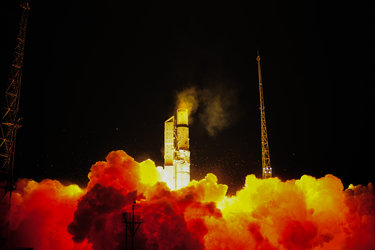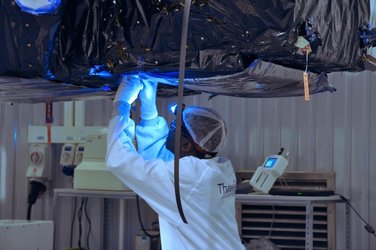Constantin Mavrocordatos: Payload Manager
Constantin Mavrocordatos has been the Sentinel-3 Payload Manager since 2006 and has been involved in the design and development of Sentinel-3 mission since its inception in 2005. He is responsible for the development of the scientific instruments on-board the satellite, up to their functional and performance verification in orbit. In an interview, Constantin talks about his role and what makes this new Sentinel and its instruments so special.

Constantin Mavrocordatos, a Greek and French national, joined ESA in 1995 as Radar Engineer in the Technical Directorate of ESA’s European Space Research and Technology Centre, ESTEC, in the Netherlands. There, among other R&D activities, he initiated the studies on a SAR/Interferometric Radar Altimeter, which later became SIRAL instrument on CryoSat. As soon as the mission was selected for implementation in 2000, he joined the Earth Observation Programmes Department as CryoSat Payload Manager, in charge for SIRAL and DORIS. In 2006, when the Sentinel-3 project started, he was appointed Sentinel-3 Payload Manager, in charge for the Optical and Microwave instruments as well as the Precise Orbit Determination equipment, forming part of the payload.
Prior to joining ESA, Constantin worked in Alcatel Espace in Toulouse (now Thalès-France) as Radar Systems Engineer and later as Project Manager for Poseidon-2 Altimeter embarked on Jason-1.
Constantin received his PhD degree in Electronics and MSc degree (DEA) from SUPAERO (Ecole Nationale Supérieure de l’Aéronautique et de l’Espace) in Toulouse, and his Electronics Engineering Degree from CPE in Lyon, France.
ESA: Can you briefly explain just what your job involves?
Constantin Mavrocordatos
Together with my team of highly qualified engineers, I am in charge for the development of the scientific instruments composing the Sentinel-3 Payload: the two large optical Instruments (OLCI and SLSTR), the two Microwave Instruments (SRAL and MWR) and finally the navigation systems used for the Precise Orbit Determination (GNSS and DORIS).
My job started at the very beginning of the project, with the establishment of the high-level system and mission requirements, driving the design of the instruments. Then, as the project entered the production phase, the character of the job evolved over time. Indeed, as these instruments involve state-of-the-art technology, every step in their development and test is full of surprises. My role has been to provide the required expertise to understand the results, to solve the problems, to define the way forward and to direct Industry accordingly, always trying to meet the requirements but also preserving the programmatic aspects: cost, schedule and risk.
ESA: What makes this new Sentinel so special in terms of the new instruments included?
Constantin Mavrocordatos
The concept of the instruments itself is not totally new, since Sentinel-3 is designed to ensure the continuation of several of the Envisat products. However, the focus of the mission is now global, requiring full coverage of the Earth by the optical sensors in a short time. This implies wider swath for the instruments with respect to their predecessors on Envisat (MERIS and AATSR) which has been a real challenge, especially for SLSTR. At the same time, other improvements have been introduced advancing the quality of the products, like higher resolution and more spectral channels in both instruments, with in addition the inclusion of dedicated channels in SLSTR for the detection of wildfires.
But also the altimeter contains innovations: it will operate in SAR mode continuously, which will allow for the first time to observe the surface of the ocean, the ice covered areas and the Land with high resolution and with dual-frequency capability. Over the ocean, this will improve the accuracy of the sea-level measurement and will make it possible to capture features – especially in the coastal areas - that are otherwise invisible with conventional altimeter techniques. Furthermore, the so-called 'open-loop' tracking capability of the altimeter will make it possible to better observe the surfaces with variable topography, like for example the ice margins and the rivers and lakes surrounded by hills.
ESA: What special measures are taken, to ensure that once in orbit the instruments will work together, since you cannot just go up and repair it if something goes wrong?
Constantin Mavrocordatos
First, we take extreme precautions in the selection of each component that will be assembled in the flight models: we make sure that it is in working condition and that it can withstand with enough margin the launch environment — which induces high mechanical loads, and afterwards the space environment with radiations and extreme thermal vacuum conditions.
Then, the instrument itself, and before each electronic box of the instrument, is submitted to an extensive test campaign which can last several months. It is then integrated into the satellite, where a new test campaign is carried out followed by a thorough functional verification.
Finally, all critical functions of the instrument are double and therefore in case of failure it is possible to replace a failed function by its redundant one. In this way we can ensure the nominal operation of the instrument in case of at least one or sometimes even several failures in flight.
ESA: Did you encounter any sort of difficulties along the way, and if so how did you deal with them?
Constantin Mavrocordatos
Yes, as with any project, we faced many difficulties of different nature. Most of them were technical, like redesign required in the early stages to cope with stringent or changing requirements, failures due to workmanship or refurbishment of equipment imposed by alerts triggered from other projects. We also faced some programmatic difficulties like bankruptcy of companies and even an earthquake, which blocked some activities for a long period.
In all cases, the anticipation or the early detection of the problem, quick decisions and the implementation of the corrective actions as early as possible were essential factors in limiting the impact on the project. To ensure this, I tried with my team to monitor as closely as possible the industrial activities and establish a good communication between the industrial and ESA teams. Furthermore, involving ESA experts from D/TEC has also been key in resolving some major technical problems requiring specialised and deep expertise.
ESA: What have been the most rewarding aspects of working on this mission?
Constantin Mavrocordatos
The work has been very dynamic and intense especially when approaching the major milestones like the final tests of an instrument or its integration in the satellite. I found it very rewarding when all our efforts as a team led to the successful completion of such major milestones.
But overall I think the most rewarding moment is still to come with the launch of Sentinel-3A. We are among the privileged engineers who soon will be able to feel that all this hard work has led to the production of such a high-tech satellite that is flying in space and producing data for scientists and engineers with the objective to monitor and protect our planet.
Editor's note:
This is one in a series of interviews with some of the key people that are involved in the Sentinel-3 mission. Please check back as further interviews will be added in over the coming weeks.









